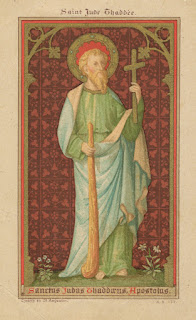ST. JUDE THADDEUS, APOSTLE AND WONDERWORKER (JUNE 19TH & OCT. 28TH)
 |
| A Contemporary Icon of St. Jude Thaddeus, Carrying the Staff and Scroll Typical of Byzantine Icons, and the Mandylion and Tongue of Fire Typical in Western Icons |
Edited and Compiled by Bp. Joseph (Ancient Church of the West)
INTRODUCTION
St. Jude Thaddeus, also called, surnamed Thaddeus, is numbered among the glorious Twelve Apostles of our Lord Jesus Christ. His name is inscribed in the Gospel lists of Sts. Matthew and Mark, distinguished from the traitor by the humility of his title and the obscurity of his fame. Yet his legacy resounds with miracle, mission, and the hidden glory of Christ made manifest to all the nations.
TRADITIONS
In the Syriac tradition, St. Jude is especially venerated as the Apostle who brought the Gospel to Edessa and Mesopotamia. He is believed by ancient tradition to be the same Jude who bore the miraculous Mandylion (the holy image of Christ not made by hands) to King Abgar of Edessa. This sacred icon, the Image of Edessa, is revered as the first icon in Christian history. It was sent as a pledge of the Lord’s healing power and divine presence. According to the ancient Doctrine of Addai, it was through Jude Thaddeus that Abgar’s plea to Jesus was answered, and the King was healed both in body and in soul. In the Mandylion we see a theology of Christ’s incarnation and saving presence that transcends mere symbol, revealing the eternal Son in visible flesh.
PENTECOSTAL POWER
Jude, filled with the Spirit at Pentecost, preached the Gospel among the peoples of Syria, Armenia, Persia, and the far East. In the Syrian Church, he is often associated with the Apostle Addai (Thaddeus), the disciple sent to Edessa in the earliest days of the Church. While some ancient traditions distinguish Jude from Addai, others regard them as one and the same, a mystery of convergence rather than contradiction, as often occurs in the oldest apostolic memories.
INDIA
His apostolic journeys brought him near to the lands traversed by Bartholomew and Thomas, and in the Indian traditions of the Mar Thoma Kali Margum (the Apostolic Way of Saint Thomas), St. Jude is venerated as having labored with Thomas and Bartholomew in Southern India. These accounts, preserved in the ancient Christian communities of Kerala, testify to a Gospel borne not only westward to Rome but eastward to Malabar, where the faith took root before the rise of the Latin Church. The Indian Church holds fast to the tradition of apostolic foundations untouched by the later disruptions of colonial Christianity.
ST. JUDE ON THE BOOK OF ENOCH
St. Jude is also remembered for his Epistle, both brief in length yet bold in voice, which calls the faithful to persevere in the ancient deposit once delivered to the saints. Within its fierce denunciation of heresy and false teachers, Jude cites a prophecy from the Book of Enoch, saying, “Behold, the Lord cometh with ten thousands of his saints.” This citation is remarkable, for it preserves within the apostolic witness a direct reference to a text once widely read among the early Church. In the Ethiopian Tawehado Orthodox Church, the Book of Enoch remains a canonical Scripture, testifying to the ancient and global reach of the early Christian imagination. Jude’s epistle thus bridges worlds - Jewish and Christian, canonical and extracanonical. He reveals the early Church’s broad inheritance of sacred tradition.
MARTYRDOM
Tradition holds that Jude Thaddeus suffered martyrdom in Persia alongside Simon the Zealot, possibly by club and axe. In iconography he is thus often depicted holding a club or halberd, and in the East, sometimes bearing the Mandylion upon his breast. He is venerated as the patron of lost causes and desperate cases, not merely because he was once a bearer of light and life to the hopeless, and because he spent his life sharing the Gospel with those who were marginal, alienated and living on the fringes of civilization.
VENERATION
St. Jude’s veneration has been strong in both the East and the West. In Syriac Christianity, he is remembered in the liturgies of the Apostolic Church of the East and the Syriac Orthodox Church, while in the Western lands, devotion to him blossomed anew in these later centuries. Yet his roots are deep in the soil of Mesopotamia, where his name was first heard, and where the face of Christ first illumined the darkness of King Abgar’s face through the holy Mandylion. In Ethiopia, India, and the Levant, the witness of St. Jude lives on as a bond between Christendom’s many tongues and traditions, united in the hope of the God-Man whom he carried out in facsimile into the world.
COLLECT
O Almighty God, who didst choose thy servant Jude Thaddeus to be numbered among the glorious company of the Twelve Apostles, and by his hand didst deliver unto King Abgar the likeness of thy blessed Son, whereby the light of the Gospel shone in the lands of Edessa and beyond: Grant unto us, thy humble servants, grace steadfastly to hold the faith once delivered, and boldly to confess thy holy Name before all men; through the same Jesus Christ thy Son our Lord, who liveth and reigneth with thee and the Holy Ghost, one God, now and for ever. Amen.
#StJudeThaddeus #ApostleJude #HolyMandylion #ImageofEdessa #WesternOrthodox #SyriacTradition #MarThomaChurch #AncientChristianity #ApostolicFaith #BookofEnoch #TawehadoOrthodox #EasternChristianity #AngloOrthodox #OrthodoxArchdiocese #AncientChurchoftheWest #AngloCeltic #JudeandSimon #IndianChristianity #KeralaChurch #GospeltoIndia #MandylionMiracle #ApostolicMissions #EarlyChurchTradition #EdessaChristianity #LostCausesSaint









Comments
Post a Comment